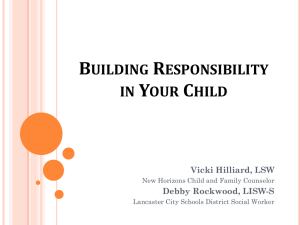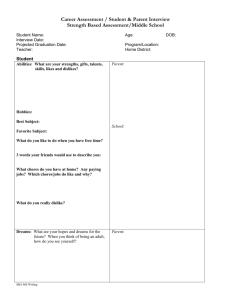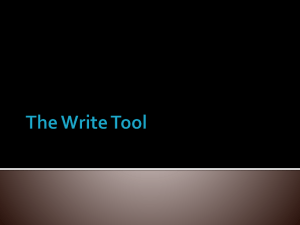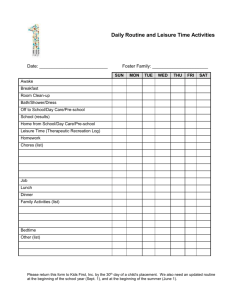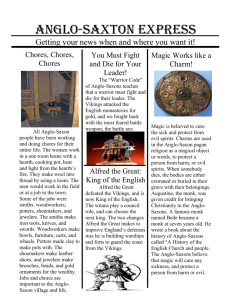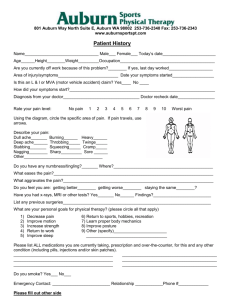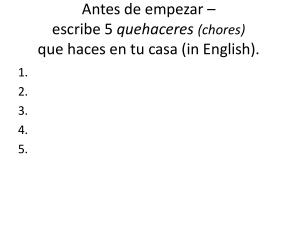Chores through Time - Midland Independent School District
advertisement
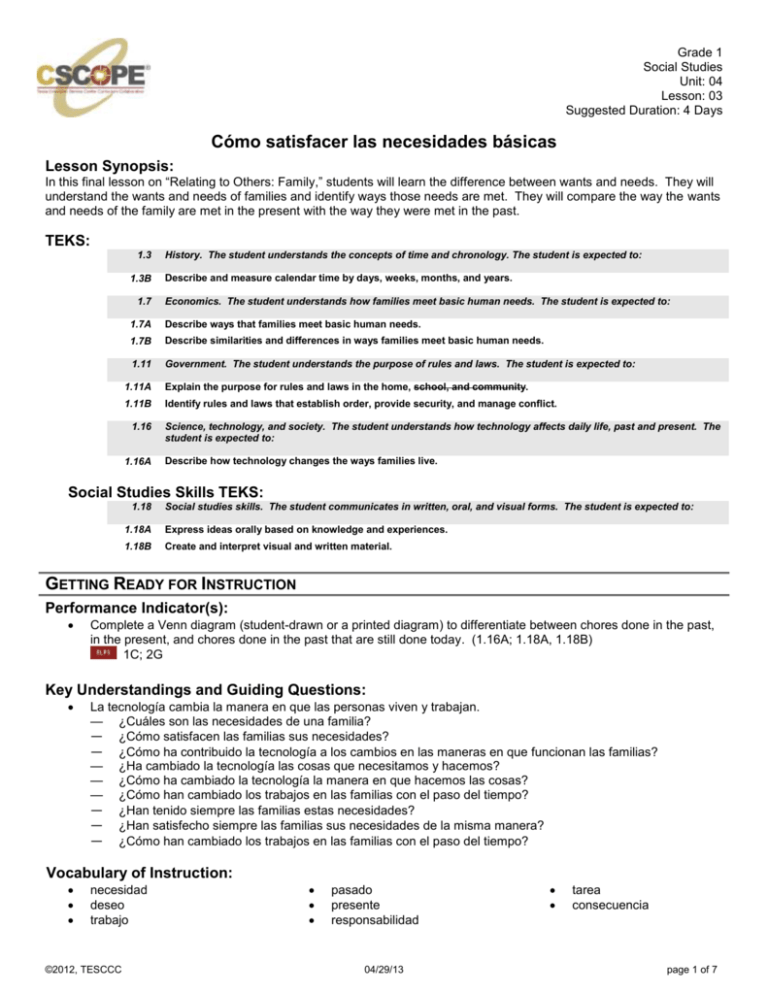
Grade 1 Social Studies Unit: 04 Lesson: 03 Suggested Duration: 4 Days Cómo satisfacer las necesidades básicas Lesson Synopsis: In this final lesson on “Relating to Others: Family,” students will learn the difference between wants and needs. They will understand the wants and needs of families and identify ways those needs are met. They will compare the way the wants and needs of the family are met in the present with the way they were met in the past. TEKS: 1.3 1.3B 1.7 History. The student understands the concepts of time and chronology. The student is expected to: Describe and measure calendar time by days, weeks, months, and years. Economics. The student understands how families meet basic human needs. The student is expected to: 1.7A Describe ways that families meet basic human needs. 1.7B Describe similarities and differences in ways families meet basic human needs. 1.11 Government. The student understands the purpose of rules and laws. The student is expected to: 1.11A Explain the purpose for rules and laws in the home, school, and community. 1.11B Identify rules and laws that establish order, provide security, and manage conflict. 1.16 1.16A Science, technology, and society. The student understands how technology affects daily life, past and present. The student is expected to: Describe how technology changes the ways families live. Social Studies Skills TEKS: 1.18 Social studies skills. The student communicates in written, oral, and visual forms. The student is expected to: 1.18A Express ideas orally based on knowledge and experiences. 1.18B Create and interpret visual and written material. GETTING READY FOR INSTRUCTION Performance Indicator(s): Complete a Venn diagram (student-drawn or a printed diagram) to differentiate between chores done in the past, in the present, and chores done in the past that are still done today. (1.16A; 1.18A, 1.18B) 1C; 2G Key Understandings and Guiding Questions: La tecnología cambia la manera en que las personas viven y trabajan. — ¿Cuáles son las necesidades de una familia? — ¿Cómo satisfacen las familias sus necesidades? — ¿Cómo ha contribuido la tecnología a los cambios en las maneras en que funcionan las familias? — ¿Ha cambiado la tecnología las cosas que necesitamos y hacemos? — ¿Cómo ha cambiado la tecnología la manera en que hacemos las cosas? — ¿Cómo han cambiado los trabajos en las familias con el paso del tiempo? — ¿Han tenido siempre las familias estas necesidades? — ¿Han satisfecho siempre las familias sus necesidades de la misma manera? — ¿Cómo han cambiado los trabajos en las familias con el paso del tiempo? Vocabulary of Instruction: necesidad deseo trabajo ©2012, TESCCC pasado presente responsabilidad 04/29/13 tarea consecuencia page 1 of 7 Grade 1 Social Studies Unit: 04 Lesson: 03 Materials: Refer to the Notes for Teacher section for materials. Attachments: Handout: Baby Bobby (1 per student) Teacher Resource: PowerPoint: Lesson 3 Handout: Ways We Meet Our Basic Needs Interview Form Teacher Resource: Visual Analysis Procedures Handout: My Chore Resources and References: Advance Preparation: 1. Become familiar with content and procedures for the lesson, especially the idea that families and communities work together to meet basic needs and that technology changes the way people live and work. 2. Refer to the Instructional Focus Document for specific content to include in the lesson. 3. Preview materials and websites according to district guidelines. 4. Gather photographs, clip art, or real material to demonstrate the difference between needs and wants and performing chores in the past and in the present. 5. Search for the poem Needs and Wants or similar text for class reading either on chart paper or an overhead transparency. 6. Make a copy of the Interview Form for each student. 7. Prepare materials and handouts as needed. Background Information: Basic Human Needs All humans require three things to survive: food, clothing, and shelter. People need food to eat, clothes to wear and shelter from the elements. . They work to make a living to buy these things, or they make them. In some cultures people make their own clothes from wool they get from the sheep they raise. Others grow cotton and spin it into cloth for themselves or to sell to businesses which spin it and make it into clothing. Farmers provide most grain and meat to factories which process it into food for distribution through grocery stores. People can choose to pay rent or buy or build their own houses. These are some ways people meet their basic human needs. Definition courtesy of the Social Studies Center [defunct]. (2000). Glossary. Austin: Texas Education Agency. GETTING READY FOR INSTRUCTION SUPPLEMENTAL PLANNING DOCUMENT Instructors are encouraged to supplement and substitute resources, materials, and activities to differentiate instruction to address the needs of learners. The Exemplar Lessons are one approach to teaching and reaching the Performance Indicators and Specificity in the Instructional Focus Document for this unit. Instructors are encouraged to create original lessons using the Content Creator in the Tools Tab located at the top of the page. All originally authored lessons can be saved in the “My CSCOPE” Tab within the “My Content” area. INSTRUCTIONAL PROCEDURES Instructional Procedures ENGAGE – The difference between wants and needs Notes for Teacher 1. Without any introduction, display three items before students: a glass of water (a need) and two “not needs” or “wants” such as a toy. (You could use pictures instead.) NOTE: 1 Day = 30 minutes Suggested Day 1 – 5 minutes Materials: Items to categorize could include water, toys, nutritious food, clothing, house, etc. 2. After displaying these three items, ask students to “turn and talk” to determine which item they could not live without. (water) Purpose: To introduce wants and needs and help students differentiate between wants and needs. 3. Facilitate a discussion using words such as: How do we get the things we need to live? Lead TEKS: 1. 3B; 1.7A; 1.7B; 1.11A; 1.11B, 1.16A, 1.18A; 1.18B ©2012, TESCCC 04/29/13 page 2 of 7 Grade 1 Social Studies Unit: 04 Lesson: 03 Instructional Procedures Notes for Teacher discussion in such a way that students conclude that families meet their basic needs by performing chores like the ones described in previous lessons, and by taking responsibility. Today, we will explore the difference between things you want and things you need. To help students differentiate between wants and needs, explain that we use money to pay for our basic needs and then buy what we want after our needs are met. Let’s pretend you’re the first settlers on the moon. What will you need? (air, water, food, clothes to keep warm, shelter to protect you) Instructional Note: Basic needs include food (also includes water and air), clothing, shelter as well as the need for companionship/belonging. Communities are formed to help the members meet needs. In this lesson we focus on food, clothing, and shelter. Wants Needs 4. Begin a t-chart of wants and needs. Post it in a convenient place to add to it during the lesson. EXPLORE – Needs and Wants Suggested Day 1 (continued) – 15 minutes 1. Search online for the song Needs and Wants or a similar text and use as a shared reading (or use a video of the poem) to focus students on the differences between needs and wants. Materials: Items such as balloons, money, a lunch box Attachments: 2. Introduce the words want and need. 3. Return to the Engage activity and look again at the three items, asking the following questions: Which of these items would not meet a basic need? Which one could we live without? Which of these would help us meet a real need? or Which one could we live without? 4. To build students’ understanding of the difference between needs and wants, give groups of students (4 or fewer students) a set of three items or pictures of items. Students look at or manipulate three items and determine whether they are a need or a want in the three categories of basic needs. 5. When groups have determined which of their items represent needs, bring students back to the floor to report. As they report, identifying items as a want or a need, create a master chart of needs and wants. 6. After the items have been sorted into Want or Need, take the Need pile and have students sort those items into the three categories of basic needs. (Food, clothing, shelter) Add these items to the t-chart that was started in the Engage section. EXPLAIN – Baby Bobby’s needs 1. Students explain their understanding of the term need by drawing the things Baby Bobby needs using Handout: Baby Bobby. 2. Introduce Bobby using words such as Baby Bobby is a happy baby because his needs have been met. Finish the picture by drawing the things Bobby needs behind him. Label them. (Label as food, clothing, shelter.) ©2012, TESCCC 04/29/13 Purpose: To help students further understand the difference between wants and needs and help students differentiate among basic needs: food, clothing, shelter. Instructional Note: Basic Needs (social studies TEKS): Food: nutritious food Clothing: body-regulated and to protect body Shelter: protect from weather and keep us safe Also (Science TEKS) Fresh Water: to drink Clean Air: to breath In this lesson we are not differentiating between want and need within a category. (We need food to survive, we want an ice cream sundae; we need a place of shelter to protect us from storms, we want mansion.) Suggested Day 1 (continued) – 10 minutes Attachments: Handout: Baby Bobby Purpose: The purpose is to provide an opportunity for students to demonstrate an understanding of needs. TEKS: 1. 3B; 1.7A; 1.7B; 1.11A; 1.11B, 1.16A, 1.18A; 1.18B page 3 of 7 Grade 1 Social Studies Unit: 04 Lesson: 03 Instructional Procedures Notes for Teacher 3. Use this opportunity to check for understanding on wants and needs. Circulate as students work and clear up any misunderstandings. ENGAGE – What does my family need? How are needs met? 1. We know individuals have basic needs, and we have been studying how these needs are met. Ask: What about families? Do families have needs? Are they the same needs? How are a family’s needs met? 2. Read aloud a book that addresses needs of families. Suggested Day 2 – 10 minutes Materials: books on the needs of the families to read aloud Purpose: To focus on the needs of families and learn how needs are met. 3. Facilitate a discussion on the needs of the families in the book. Compare them to Teddy’s needs and the needs listed on the t-chart. TEKS: 1. 3B; 1.7A; 1.7B; 1.11A; 1.11B, 1.16A, 1.18A; 1.18B EXPLORE/EXPLAIN – Chores in the past & present Suggested Day 2 (continued) – 20 minutes 1. Say: Let’s think back to the jobs you do in your family. What needs do your jobs help your family meet? (Example: Jobs that have to be done in order for the basic need of fresh water to be met include paying the bills and having clean glasses - so washing dishes.) Do you remember what it means to do that job well? Do you remember the criteria for a job well done? (completing the job to the best of your ability, in a timely manner) Do you think people have always met basic needs in the same way? (No, because machines and technology have changed the way we meet needs.) For homework tonight, you are going to interview a parent, grandparent, or other “older person” to find out about the jobs they did in their families when they were young. Distribute Handout: Ways We Meet Our Basic Needs Interview Form. Let’s take a look at some of the chores people long ago had to do to meet their basic needs. Materials: Task pictures (from Library of Congress) (copies for students to study up close) 2. Show the Teacher Resource: PowerPoint: Lesson 3 and discuss chores done long ago. Ask: What is meant by “long ago?” 3. Point to the monthly calendar and ask students to name day, week, and month as different periods of time. Display a calendar that shows 12 months or a year. Continue the explanation using words such as: When we use the words “long ago,” we are referring to the time when your parents or your grandparents were children. That could be as many as 50 or more years ago. Attachments: Teacher Resource: PowerPoint: Lesson 3 Handout: Ways We Meet Our Basic Needs Interview Form Teacher Resource: Visual Analysis Procedures Handout: My Chore ____ Purpose: The purpose is to learn about chores that were done in the past and compare them to chores done today and understand how chores help meet basic needs. TEKS: 1. 3B; 1.7A, 1.7B; 1.11A, 1.11B, 1.16A, 1.18A, 1.18B Instructional Note: If students do not have someone to interview at home, arrange to have them interview a faculty member. If students are unable to write the information on the interview form, the person interviewed may write the information for the student as they discuss the questions aloud. 4. Optional: Use the visual analysis process to help students begin to analyze historic photographs – photographs from long ago, Teacher Resource: Visual Analysis Procedures. (This may be too advanced for some grade 1 students.) ©2012, TESCCC 04/29/13 page 4 of 7 Grade 1 Social Studies Unit: 04 Lesson: 03 Instructional Procedures Notes for Teacher 5. Allow time for students to report on their discussion and discoveries; perhaps each student in the circle will “Tell One Thing.” 6. Say: From the pictures in the Powerpoint, choose a chore to talk about with your tablemates. Talk about the changes in how people do chores today as compared to a long time ago. What has made a difference? Maybe some of the chores aren’t done any more, or maybe they have changed a great deal. Has technology changed this chore? If so, how has technology changed this chore? After you talk about the pictures for a few minutes, draw two pictures side by side. The picture on the left is of you doing a chore like the one in the pictures you just studied. The picture on the right is of someone doing the chore a long time ago. Point out something different between the two. 7. Remind students to interview their parents about the chores they did when they were young. Suggested Day 3 – 5 minutes ENGAGE – Review PowerPoint 1. Review Teacher Resource: PowerPoint, Lesson 3 from previous day. 2. Students gather in the front of the room with their interviews. Review good audience behavior. Suggested Day 3 (continued) – 15 minutes EXPLORE – Presentation of interviews 1. One by one, students present their interviews. 2. As the students report, the teacher scribes the jobs parents did on sentence strips. Display these sentence strips in a pocket chart. Make at least one per child. 3. As students report, other students listen to learn about chores done in families in the past. 4. Ask: Are there any chores you perform at home that are not recorded that might help meet the basic needs of your family? List any additional chores. Be sure to include chores that are accomplished using specific technology. (For example, bills are paid online using a computer. We use riding lawnmowers to take care of the yard, and we use washing machines to clean clothes.) EXPLAIN – Check for understanding: chores in the past Suggested Day 3 (continued) – 10 minutes and present ©2012, TESCCC 04/29/13 page 5 of 7 Grade 1 Social Studies Unit: 04 Lesson: 03 Instructional Procedures Notes for Teacher 1. Hand each child one of the sentence strips. Students form two concentric circles facing each other. Materials: Sentence strips 2. Say: Talk about the chore on your sentence strip, including any changes in the way the chore is done today as compared to the way it was done in the past. Maybe some of the chores were only done in the past. Maybe some of the chores are only done today. Maybe some of the chores were done in the past and are still being done in the present. Purpose: The purpose is to learn about chores that were done in the past and compare them to chores done today and understand how chores help meet basic needs. TEKS: 1. 3B; 1.7B; 1.11A; 1.11B, 1.16A, 1.18A; 1.18B 3. Give students directions such as “inside circle, move two people to your left” and repeat. Repeat a couple of times to allow students to listen and talk several times. 4. Return the sentence strips to the pocket chart. ENGAGE – Who are authority figures at home? Suggested Day 4 – 10 minutes 1. Ask: Who are authority figures in the home? (parents, possibly grandparents, or other adults who live in the home) What roles do they play in the family? They help keep family members safe and secure and make sure chores and jobs are completed appropriately, safely, and in a timely manner.) Materials: A book with a home authority figure as an important character 2. Read aloud a book with an authority figure in the home who provides a safe, secure, and conflict-free atmosphere and ensures chores and jobs within the home are accomplished safely and in a timely manner. Purpose: The purpose is to identify authority figures at home and the role they play in keeping us safe, secure, and our environment conflict-free, as well as ensure chores and jobs at home are accomplished safely. TEKS: 1. 3B; 1.7B; 1.11A; 1.11B, 1.16A, 1.18A; 1.18B 3. Ask: What do authority figures do to help ensure chores and jobs at home are accomplished? (They make the expectation of the chore or job clear, they decide who completes the chore or job, they teach how to complete the chore, and they decide and communicate what is a job well done and the time frame in which the job should be completed.) EXPLORE/EXPLAIN – Stories of authority figures 1. Tell a story from your (the teacher’s) life when a family authority figure (parent, grandparent, older sibling) stepped in and resolved a conflict, helped keep you safe, ensured that a chore was completed appropriately, provided support, and provided a secure atmosphere. 2. Discuss relying on others in the family as one way members of families interact. Suggested Day 4 (continued) – 10 minutes Instructional Note: For example, tell about a time when your parent wanted you to mow the lawn. Your parent showed you how to safely mow. Another example might be when a family member explained why people have to be sixteen or older to drive – even though kids often want to drive themselves places (a parent’s chore). 3. Have students tell stories about a time an authority figure was needed and someone in their family acted as an authority figure. ©2012, TESCCC 04/29/13 page 6 of 7 Grade 1 Social Studies Unit: 04 Lesson: 03 Instructional Procedures Notes for Teacher ELABORATE – Review key understandings Suggested Day 4 (continued) – 10 minutes 1. Relate learning back to the Key Understandings through the use of a timeline and pictures. Discuss the questions as the students are placing the pictures in the appropriate area. Technology changes the way people live and work. What are the needs of a family? How do families meet their needs? How has technology contributed to the change in ways families operate? Has technology changed the things we need and do? How has technology changed the way we do things? How have jobs in families changed over time? Have families always has these needs? Have families always met their needs in the same ways? How have jobs in families changed over time? Purpose: The purpose is to learn about chores that were done in the past and compare them to chores done today and understand how chores help meet basic needs. EVALUATE Suggested Day 5 (continued) – 25 minutes Complete a Venn diagram (student-drawn or a printed diagram) to differentiate between chores done in the past, in the present, and chores done in the past that are still done today. (1.16A; 1.18A, 1.18B) 1C; 2G TEKS: 1. 3B; 1.7B; 1.11A; 1.11B, 1.16A, 1.18A; 1.18B Instructional Note: Sample timeline: Past (long ago) Present Instructional Note Suggested Venn pattern: 1. Students complete a Venn diagram individually. Past 2. Use a rubric to score. ©2012, TESCCC 04/29/13 Both Present page 7 of 7
